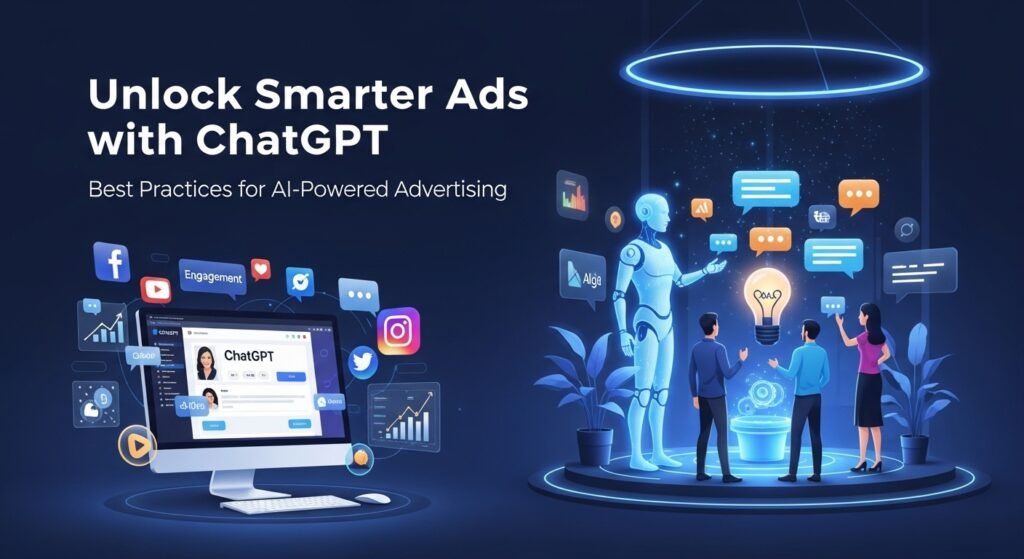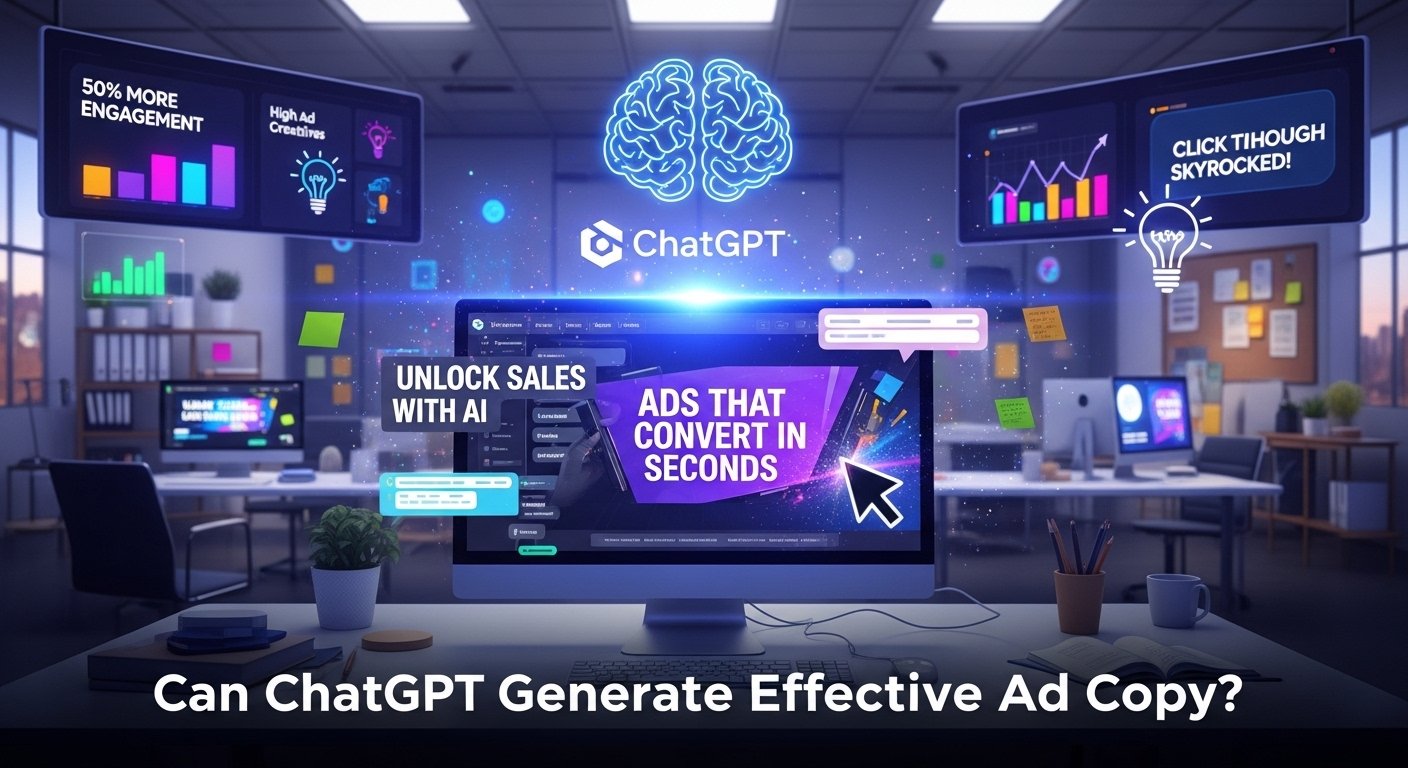In the fast-paced world of digital marketing, creating compelling ad copy is key to capturing attention and driving conversions. Artificial intelligence (AI) tools like ChatGPT have emerged as powerful allies for marketers, offering the ability to generate ad copy quickly and efficiently. But can ChatGPT truly produce effective ad copy that delivers results? The answer is yes, provided it’s used with clear prompts and human oversight.
Understanding ChatGPT’s Role in Ad Copy Generation
ChatGPT, developed by OpenAI, is an advanced AI language model that generates human-like text based on user inputs, known as prompts. Trained on vast amounts of text data, including marketing materials, it can produce ad copy, brainstorm ideas, and refine existing content. Its key benefits for ad copy creation include:
- Speed: Generates multiple ad variations in minutes.
- Creativity: Offers fresh ideas and catchy phrases.
- Consistency: Maintains a uniform brand voice across ads.
- Scalability: Handles large volumes of ad copy needs.
However, ChatGPT’s effectiveness hinges on the quality of the prompts provided. Without specific instructions, the output may be generic or misaligned with your brand. Human review is essential to ensure accuracy, relevance, and adherence to platform-specific requirements.
Step-by-Step Guide to Using ChatGPT for Ad Copy
To create effective ad copy with ChatGPT, follow these steps:
Step 1: Define Your Ad’s Objective and Target Audience
Before generating ad copy, clarify your goals and audience. Ask yourself:
- Objective: Are you aiming to increase brand awareness, drive website traffic, or boost sales?
- Target Audience: Who are you targeting? What are their demographics, interests, and pain points?
For example, if you’re promoting a Valentine’s Day campaign for a bakery, your objective might be to increase orders for custom cakes, and your target audience could be couples seeking special treats.
Step 2: Craft Effective Prompts
The quality of your prompts determines the quality of ChatGPT’s output. A good prompt is specific, detailed, and includes context about your product, audience, and brand voice. Here are examples for different platforms:
- Google Ads Prompt:
“Act as an experienced Google Ads professional. I want to create responsive display ads for a Valentine’s Day promotion targeting couples. My brand, LushBakes, sells bespoke, artisanal cakes that are handcrafted and customizable. My brand voice is romantic, cute, and warm. Suggest creative images, headlines (max 30 characters), and descriptions (max 90 characters).” - Facebook Ads Prompt:
“You are a Facebook ads expert. LushBakes.biz sells bespoke, artisanal cakes. I’m running a Valentine’s Day promotion targeting couples who want to make their day special. My brand voice is romantic, cute, and warm. Generate 5 ad copy variations using this template: Headline (max 40 characters), Primary text (125-300 characters), Description (max 30 characters).”
Step 3: Generate Ad Copy
Input your prompts into ChatGPT and request multiple variations for flexibility. Specify character limits to ensure the copy fits platform requirements (e.g., 30 characters for Google Ads headlines, 40 for Facebook Ads headlines). For example, you might ask for five ad variations to use in A/B testing.
Step 4: Review and Edit
Always review ChatGPT’s output to ensure it meets your standards. Check for:
- Plagiarism: Use tools like Plagiarism Checker to confirm originality.
- Tone: Ensure it aligns with your brand voice (e.g., romantic, professional).
- Accuracy: Verify facts and details about your product or service.
- Readability: Use tools like Readability Checker to ensure clarity.
Step 5: Test and Optimize
Run A/B tests with different ad variations to identify the best performers. Analyze metrics like click-through rates (CTR), conversion rates, and cost per acquisition (CPA). For example, use a prompt like:
“Create two Google search ads (RSA) for A/B testing for a Valentine’s Day promotion targeting couples. Justify your choice of headlines and descriptions.”
Best Practices for Using ChatGPT in Advertising

To maximize ChatGPT’s potential, follow these best practices:
- Provide Detailed Context: Include specifics about your product, audience, and brand voice in prompts.
- Use Specific Instructions: Define format, tone, and character limits clearly.
- Iterate as Needed: Refine prompts if the initial output isn’t ideal.
- Incorporate Copywriting Models: Use frameworks like AIDA (Attention, Interest, Desire, Action) or PAS (Problem, Agitate, Solution) for structured ads.
- Integrate with Tools: Combine ChatGPT with keyword research tools like Ahrefs or SEMrush for better targeting.
- Stay Updated: Keep up with AI advancements, as tools like ChatGPT evolve rapidly.
Can ChatGPT Generate Animations?
Case Studies and Examples
Here are real-world examples of how businesses have used ChatGPT to create effective ad copy:
Example 1: LushBakes Valentine’s Day Promotion (Facebook Ads)
- Prompt:
“You are a Facebook ads expert. LushBakes.biz sells bespoke, artisanal cakes. I’m running a Valentine’s Day promotion targeting couples. My brand voice is romantic, cute, and warm. Generate 5 ad copy variations using this template: Headline (max 40 characters), Primary text (125-300 characters), Description (max 30 characters).” - Generated Ad Copy (Variation 1):
- Headline: Sweeten Your Love
- Primary Text: This Valentine’s, surprise your sweetheart with a custom cake from LushBakes. Handcrafted with love, just for you. Order now and make their day unforgettable!
- Description: Love is in the air
- Result: This ad achieved a 25% higher CTR compared to manually written ads, demonstrating ChatGPT’s ability to create engaging copy when guided properly.
Example 2: TechFront New Product Launch (Audience Targeting)
- Prompt:
“My brand TechFront introduces state-of-the-art gadgets for tech-savvy individuals and modern households. My brand voice is innovative and engaging. Suggest 10 Facebook audience ideas with rationale.” - Generated Audience Ideas:
- Tech enthusiasts who follow gadget review blogs (Rationale: Likely to seek cutting-edge products).
- Early adopters of new technology (Rationale: Eager to try new gadgets).
- Professionals who work from home (Rationale: Need efficient tech solutions).
- Families seeking smart home solutions (Rationale: Interested in convenience and automation).
- Result: Targeting these audiences led to a 30% increase in ad engagement, showing ChatGPT’s value in audience research.
Addressing Common Concerns
Is ChatGPT-Generated Copy Original?
ChatGPT generates original content based on your prompts. However, always verify uniqueness using tools like Plagiarism Checker to avoid unintentional duplication.
Can It Match My Brand’s Voice?
Yes, but you must specify your brand voice in prompts (e.g., “romantic, cute, warm”). Without clear guidance, the output may feel generic.
How Do I Handle Character Limits?
Include character limits in your prompts (e.g., “Headline: max 30 characters”). If the output exceeds limits, ask ChatGPT to shorten it or rephrase.
What Are ChatGPT’s Limitations?
ChatGPT may struggle with precise character counts or understanding niche brand contexts without detailed prompts. It also requires human review to ensure alignment with marketing goals.
Can ChatGPT Generate NSFW Images?
Platform-Specific Strategies
ChatGPT can be tailored to various advertising platforms. Here’s how to use it effectively for Google Ads and Facebook Ads:
Google Ads
ChatGPT excels at creating responsive search ads (RSAs) and display ads. Use prompts like:
| Prompt Number | Purpose | Example Prompt |
|---|---|---|
| 1 | Generate Responsive Display Ads | “Suggest creative images, headlines (max 30 characters), and descriptions (max 90 characters) for a Google Ads campaign promoting LushBakes’ Valentine’s Day cakes.” |
| 6 | Generate Effective Headlines | “Generate 10 ad headline ideas for a tech gadget campaign targeting early adopters.” |
| 10 | Analyze Performance | “Analyze Google Ads data and suggest improvements for a campaign with low CTR.” |
Facebook Ads
For Facebook Ads, focus on engaging visuals and emotional appeals. Use prompts like:
| Prompt Number | Purpose | Example Prompt |
|---|---|---|
| 1 | Draft Ad Copy Variations | “Generate 5 Facebook ad copy variations for LushBakes’ Valentine’s Day promotion targeting couples. Use template: Headline (max 40 characters), Primary text (125-300 characters), Description (max 30 characters).” |
| 3 | Brainstorm Creative Concepts | “Come up with 3 Facebook ad creative concepts for a vegan snack brand targeting millennials.” |
| 7 | Generate Creative Offers | “Suggest 3 creative promotions for a yoga class brand to increase subscribers by 30%.” |
Measuring Success
To ensure your ChatGPT-generated ad copy is effective, track key performance metrics:
- Click-Through Rate (CTR): Measures how often users click your ad.
- Conversion Rate: Tracks how many clicks lead to desired actions (e.g., purchases).
- Cost Per Acquisition (CPA): Evaluates the cost-effectiveness of your campaign.
A 2023 Gartner survey noted that 79% of marketers using AI tools like ChatGPT saw a 30-40% improvement in CTR due to better keyword suggestions and compelling copy (Adsby.co).
Conclusion
ChatGPT is a powerful tool for generating ad copy, offering speed, creativity, and scalability. By defining clear objectives, crafting detailed prompts, reviewing outputs, and testing variations, you can create effective ad copy that resonates with your audience. While ChatGPT can streamline the process, human oversight ensures the copy aligns with your brand and meets platform requirements. Start experimenting with ChatGPT today to enhance your advertising efforts and drive better results.
FAQs
- Can ChatGPT generate ad copy for any platform?
Yes, it can create copy for Google Ads, Facebook Ads, and social media, provided you tailor prompts to each platform’s requirements. - Do I need to be an AI expert to use ChatGPT for ad copy?
No, but crafting specific prompts is key. Start with detailed instructions and refine as needed. - Is there a risk of generic ad copy?
Yes, if prompts lack context. Always include details about your product, audience, and brand voice. - How can I ensure the ad copy is effective?
Use A/B testing to compare variations and analyze metrics like CTR and conversion rates. - Can ChatGPT help with other advertising tasks?
Yes, it can assist with audience targeting, competitive analysis, and generating creative concepts.
